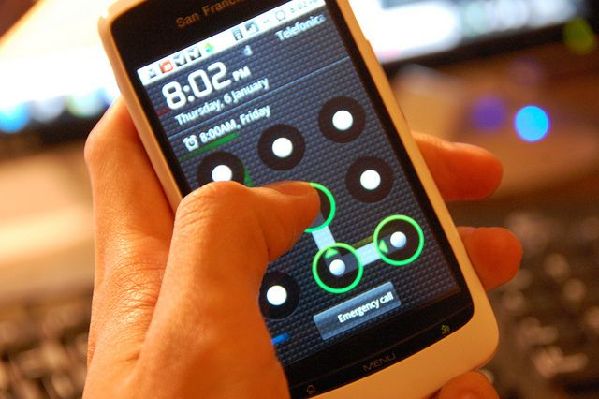當(dāng)前位置: Language Tips> 雙語(yǔ)新聞
Beware, your lock screen passcode probably isn't very secure: 75% of us start secret patterns from a corner, study reveals
We all know that passwords such as ‘12345’ and ‘password1’ are far from secure, but how about your lock screen pattern for your smartphone? A study shows that most of us use similar patterns to unlock our handsets, meaning they could be easily guessed by criminals.
我們都知道,“12345”或“password1”這樣的密碼非常不安全,但是你使用的智能手機(jī)的鎖屏圖形安全性又如何呢?一項(xiàng)研究顯示,我們多數(shù)人都會(huì)使用相似的圖形來(lái)解鎖手機(jī)。這就意味著,解鎖圖形很容易地就會(huì)被犯罪分子猜到。

More than three quarters of people start their lock screen patterns from a corner, according to the researcher behind the worrying work. Marte L?ge, a graduate of the Norwegian University of Science and Technology, also said 44 per cent of study participants start their Android lock screen pattern ‘password’ from the top left corner.
這項(xiàng)引人擔(dān)憂的研究背后的研究人員稱,超過四分之三的手機(jī)用戶所使用的鎖屏圖形從四個(gè)邊角之一開始。挪威理工大學(xué)(Norwegian University of Science and Technology)的研究生馬爾特·洛格還表示,在所有研究參與者中,有44%的人為自己的安卓手機(jī)設(shè)置的鎖屏圖形“密碼”都從左上角開始。

She found that around 10 per cent of patterns create a letter, such as an N or C, which more often than not corresponded to a user's own name, or that of a loved one, Ars Technica reported. She presented her findings into Android lock patterns, which were introduced in 2008, at PasswordCon in Las Vegas last week.
據(jù)科技博客媒體Ars Technica報(bào)道,洛格發(fā)現(xiàn),大約10%的解鎖圖形會(huì)構(gòu)成一個(gè)字母,比如N或C。多數(shù)時(shí)候,這些字母都與用戶自己或親近的人的名字對(duì)應(yīng)。安卓圖形解鎖于2008年推出。上周,洛格在拉斯維加斯舉行的密碼保護(hù)研討會(huì)(PasswordCon)展示了自己針對(duì)安卓手機(jī)的圖形解鎖的研究成果。
Ms L?ge sampled 4,000 user-generated Android lock patterns as part of her thesis. She asked study participants to create three Android lock patterns – one for an imaginary shopping app, another for a fake banking app and one to unlock a phone.
洛格在其論文中取樣了4000個(gè)用戶自創(chuàng)的安卓解鎖圖形。她要求研究參與者創(chuàng)造出三個(gè)安卓鎖屏圖形——一個(gè)用于一款虛構(gòu)的購(gòu)物應(yīng)用,一個(gè)用于一款虛構(gòu)的銀行應(yīng)用,一個(gè)用于解鎖手機(jī)。
She found that most people chose to create a pattern that travelled through the minimum amount of nodes of spots – four – making their pattern much less secure than if they opted for the maximum number of nodes. The average number of nodes used was five, meaning there were less than 8,000 possible pattern combinations, but this dropped to just 1,624 for four node patterns.
她發(fā)現(xiàn),大多數(shù)人用的圖形都只使用了最少的節(jié)點(diǎn),即四個(gè)節(jié)點(diǎn)。與選擇使用最多節(jié)點(diǎn)相比,這樣做會(huì)大大降低安全系數(shù)。用戶平均使用的節(jié)點(diǎn)數(shù)為五個(gè),這意味著總共可以產(chǎn)生不到8000個(gè)可能的圖形組合。但如果只使用四個(gè)節(jié)點(diǎn),那么這個(gè)數(shù)字將會(huì)降到1624。
Ms L?ge found that most people chose patterns that moved from left to right, making guessing combinations slightly easier.
洛格發(fā)現(xiàn),多數(shù)人選擇的圖形都是從左向右移動(dòng),這樣使猜到密碼的難度又稍微降低了一些。
Men were more likely than women to choose long and complicated patterns, but interestingly there was little difference between the patterns chosen by right-handed and left-handed participants.
與女性相比,男性選擇復(fù)雜的長(zhǎng)密碼的可能性更高。但是有趣的是,右撇子和左撇子用戶創(chuàng)造的圖形并未有很大不同。
‘Humans are predictable,’ Ms L?ge told Ars. ‘We're seeing the same aspects used when creating a pattern locks [as are used in] pin codes and alphanumeric passwords.’
洛格告訴Ars Technica:“人們的行為很容易預(yù)測(cè)。不管是解鎖圖形密碼、PIN碼還是字母數(shù)字組合的密碼,人們的設(shè)置習(xí)慣都是一樣的。”
She believes that using 'crossovers' to bamboozle onlookers and not starting from a corner produces the safest password patterns. Using a long and complex password is also unsurprisingly more secure.
她認(rèn)為,使用“交叉”圖形迷惑“有心的”旁觀者以及不從邊角開始繪制圖形可以設(shè)置出最安全的密碼圖形。意料之中的是,使用復(fù)雜的長(zhǎng)密碼也更為可靠。
Vocabulary
corresponded to:與…相對(duì)應(yīng)
node:節(jié)點(diǎn)
alphanumeric: 字母數(shù)字(混合編制)的
bamboozle:迷惑,欺騙
英語(yǔ)來(lái)源:每日郵報(bào)
譯者:Zoella
審校&編輯:劉明
上一篇 : 美夫婦一塊婚禮蛋糕吃60年
下一篇 : 德國(guó)女大學(xué)生火車安家
關(guān)注和訂閱


口語(yǔ)
關(guān)于我們 | 聯(lián)系方式 | 招聘信息
電話:8610-84883645
傳真:8610-84883500
Email: languagetips@chinadaily.com.cn